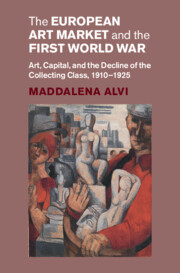 The European Art Market and the First World War
The European Art Market and the First World War Book contents
- The European Art Market and the First World War
- Studies in the Social and Cultural History of Modern Warfare
- The European Art Market and the First World War
- Copyright page
- Dedication
- Epigraph
- Contents
- Figures
- Acknowledgements
- Introduction
- 1 The European Market before 1914
- 2 The Great Conflagration (1914–1918)
- 3 ‘Wartime Cultural Changes’ (1914–1918)
- 4 Postwar Markets (1918–1925)
- 5 ‘The Challenges of New Markets’
- 6 Cementing Nationalisation (1918–1925)
- Conclusion
- Bibliography
- Index
1 - The European Market before 1914
Published online by Cambridge University Press: 10 April 2025
- The European Art Market and the First World War
- Studies in the Social and Cultural History of Modern Warfare
- The European Art Market and the First World War
- Copyright page
- Dedication
- Epigraph
- Contents
- Figures
- Acknowledgements
- Introduction
- 1 The European Market before 1914
- 2 The Great Conflagration (1914–1918)
- 3 ‘Wartime Cultural Changes’ (1914–1918)
- 4 Postwar Markets (1918–1925)
- 5 ‘The Challenges of New Markets’
- 6 Cementing Nationalisation (1918–1925)
- Conclusion
- Bibliography
- Index
Summary
This chapter explores the major auction landscapes before 1914 and also describes the defining elements of the fin-de-siècle European market: integration, free trade, and cosmopolitanism. Examining societies’ approaches to artwork acquisition unveils contradictions and frictions within a milieu united by an international collecting class. France contended with an international, yet conservative, nationalist art world, while Germany’s bourgeoisie tried to control the world of luxury and consumption. In contrast, Britain grappled with questions about free trade and the preservation of art that challenged its laissez-faire tradition. It is precisely these tensions, which directly reflect the challenges posed by the commercialisation of art, that provide a framework for analysing the impact of the war. By emphasising the shared features of an integrated trade sphere, this chapter paints a balanced portrayal of a European market, where art mirrored the complex integration of both socioeconomic and cultural frameworks.
Keywords
- Type
- Chapter
- Information
- The European Art Market and the First World WarArt, Capital, and the Decline of the Collecting Class, 1910–1925, pp. 11 - 65Publisher: Cambridge University PressPrint publication year: 2025
